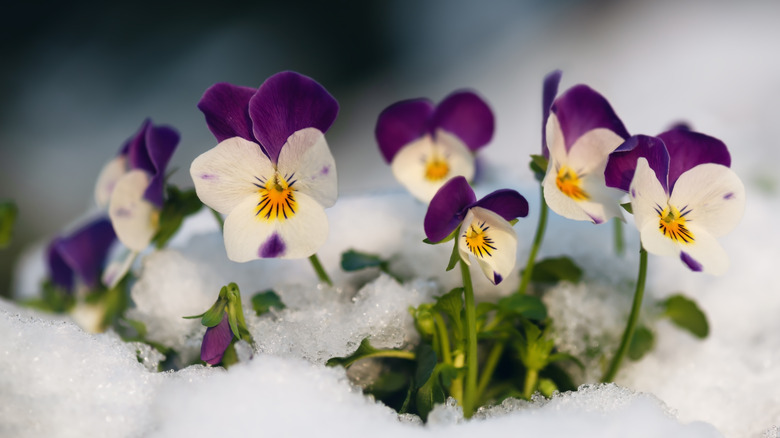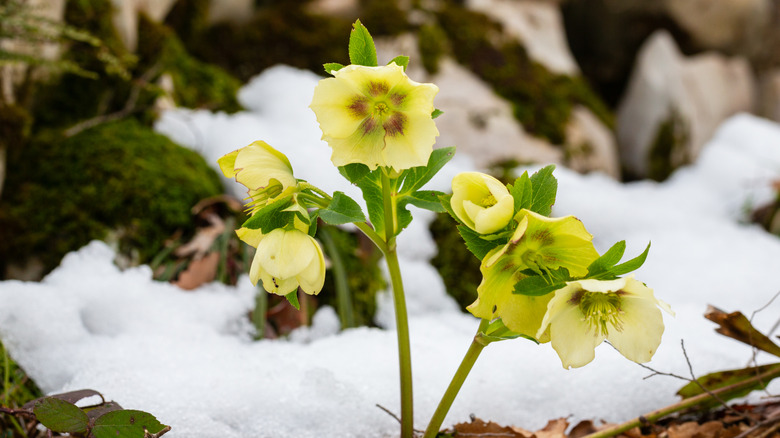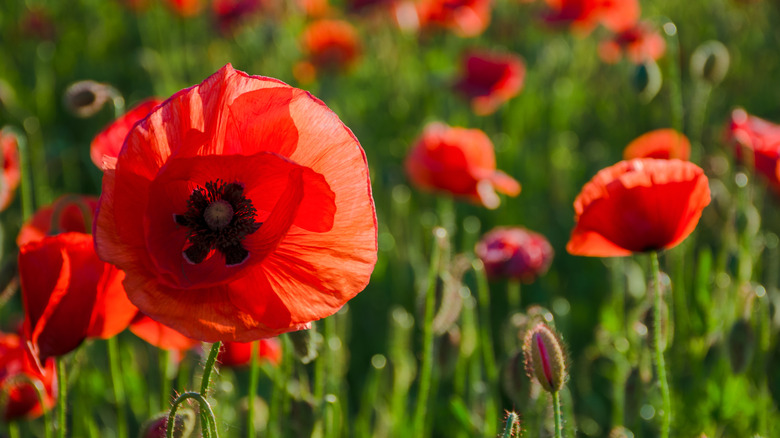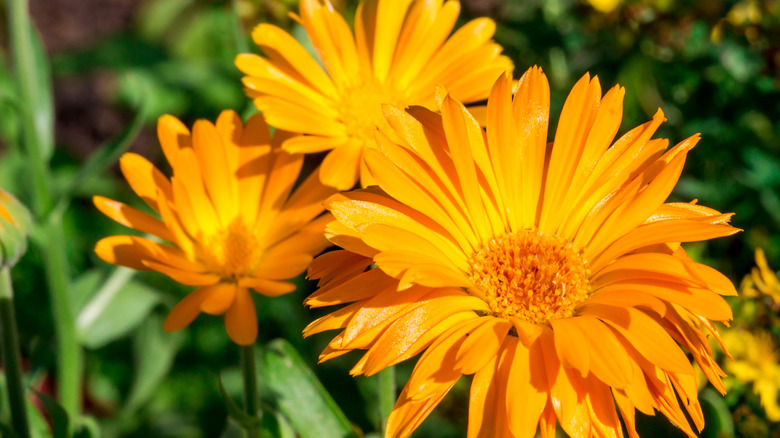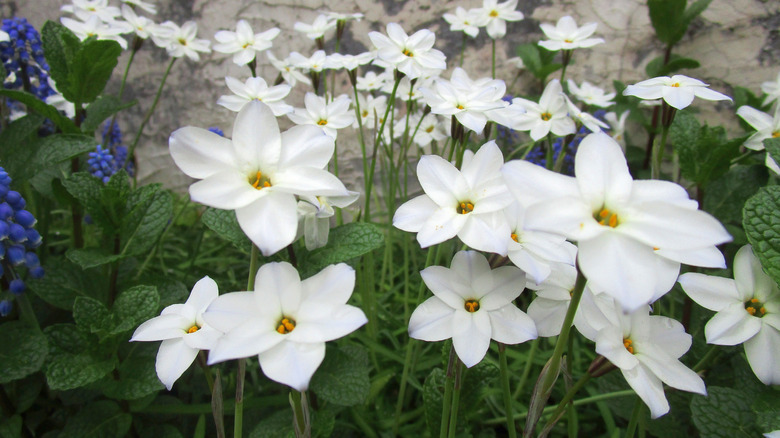12 Flowers To Plant In December For A Burst Of Color In Winter & Spring
On the surface, flower gardens sound pretty straightforward and simple. You plant your flora in the spring, enjoy them in the summer, and clean up your garden in the fall. Then, you wait through winter until you can replant again or start germinating plants indoors. However, it's really not that simple. Like the rest of life, not everything fits perfectly where you expect it to. Some flowers do better when planted in fall, summer, or even winter, and they may bloom at different times of the year as well. For example, plants like tulips, pansies, and poppies do extremely well in their zones after being planted in December.
While you may think that December is too late to plant any flowers for an early spring bloom — waiting until the last frost of the season to sow your seeds — there are actually plenty of plants you can start in the winter to get ready for the new season. This is true even if you live in colder zones. Certain flowers need a period of cold, or a process of freezing and thawing, before they can fully bloom. For these kinds of flowers, as long as your soil isn't frozen, you can start growing them in your garden.
Tulips
Tulips (Tulipa spp.) do great when planted in the winter. The bulbs generally handle soil temperatures between 38 and 50 degrees Fahrenheit. These flowers do well in zones 4 through 10, and can bloom in colder weather. Plant your tulips about six to eight weeks before your last predicted frost, so they get all of the cold hours they need to bloom in the spring. They come in a range of colors, and you can plant multiple varieties in your garden for a rainbow of blooms that are sure to make a statement.
Coneflowers
Coneflowers (Echinacea spp.) do well when planted in the winter, as it gives their roots time to establish themselves before spring arrives. They are hardy in USDA zones 4 through 9, though some varieties can handle an extra zone or two in either direction. They tolerate cold conditions well and will even flourish while covered in snow. There are many varieties of coneflower you can grow from seed for a budget-friendly garden, letting you fill your yard with beautiful blooms early in the year.
Pansies
While pansies (Viola spp.) are beautiful flowers you can plant in August for colorful blooms that last into winter, they are versatile in their sowing season. All pansies can be planted in December as long as the temperatures don't get much below freezing, but there is another kind that handles the cold well. Specifically, winter pansies (Viola hiemalis) are best planted when temperatures are between 45 and 65 degrees Fahrenheit. Once established, they can handle temperatures down to 20 degrees. Pansies are hardy in zones 6 through 10, while winter varieties prefer zones 4 through 10.
Larkspur
Larkspur (Delphinium spp.) prefers cooler areas and thrives in zones 3 through 7. In fact, if you're in a zone cold enough, they can be a perennial, but the heat will kill them in warmer zones, so it's best to plant these in the colder seasons. As long as temperatures are above about 25 degrees Fahrenheit, delphinium can thrive without any covers. As long as you keep the soil moist when they are planted and cover the ground with mulch, they should make it through the winter without much trouble.
Snapdragons
If you want to enjoy your snapdragons (Antirrhinum spp.) for a longer period during the spring, planting them in late fall or winter is a great option. They don't do well in very cold temperatures and are hardy in zones 7 through 11. In the warmer areas of their range, they can be sown in the winter for early spring blooms. These are slow-growing flowers and can take two or three months to flower after germination, so starting them early is key. Additionally, once they are established, they can handle colder temperatures fairly well.
Bachelor's buttons
Bachelor's buttons (Centaurea cyanus) are a quick-growing flower that only needs 65 days or so from seed to create stunning blooms. Planting them sometime in December could mean you get flowers as early as February. They can handle temperatures below freezing and tend to be stronger when grown during colder seasons. They are hardy across almost the entirety of the United States, specifically zones 2 through 11; however, they should not be grown in Georgia or West Virginia, where they are considered invasive. They also reseed naturally, giving way to new flowers every few months.
Crocuses
Crocuses (Crocus spp.) are a plant that can tough out colder weather. In fact, if soil temperatures are too warm — above 60 degrees Fahrenheit — they will bloom early, so in some zones it may be best to wait until December, when it starts to cool down enough. Many varieties of crocuses are hardy during the winter in zones 3 through 8, especially snow (Crocus chrysanthus) and Dutch (Crocus vernus) varieties. As long as the ground hasn't frozen yet, you can plant them during December in these regions.
Hellebores
Hellebores (Helleborus spp.) love cold weather and are hardy in zones 3 through 9. These flowers can be planted any time between fall and spring. Essentially, as long as the ground isn't yet frozen, it is a great plant to sow in your garden in December. They create long-lasting flowers that last around three months to give you plenty of color to get you through the season until your other spring blooms appear. They are long-living perennials you can enjoy for years to come, and are rich in nectar for your early hummingbirds.
Poppies
Poppies (Papaver spp.) are another great flower to start in December. In fact, the perfect time of year for planting poppies is in the winter. They need cold stratification to thrive, which occurs when they undergo a period of freezing and thawing. Having originated from the Arctic Circle, it's not surprising that they like cooler temperatures. When you plant them in winter, you will have poppy blooms by spring. These flowers are perennials in colder zones 3 through 8, but you can also grow them as early-season annuals in warmer areas.
Grape hyacinths
Depending on where you live, you can plant grape hyacinths (Muscari armeniacum) as late as December. They are hardy in zones 4 through 8, and for most of this range, the best time to plant them is in the fall; if your winters are warm, however, you may be able to start them in December. They require cool, but not frozen, soil to thrive. However, remember that bulbs need a cold period, so if temperatures usually start warming back up in early spring, it may be worth refrigerating your grape hyacinth for a few weeks before planting.
Calendula
If you've planted calendula (Caldendula officinalis) before, it will likely winter sow on its own, but you can also take seeds and do it yourself. These flowers will handle some light frost, so if you live in a climate where you don't have to worry about hard frosts, then you can plant them in December. Calendula is primarily an annual that will reseed itself, especially in zones 4 through 8. However, in zones 9 through 11, it can be grown as a perennial. They produce bright orange and yellow flowers, perfect for adding some sunshine to shorter days.
Starflowers
Starflowers (Ipheion uniflorum) are a spring flower found in many of the northern parts of the United States. Their beautiful white flowers may not catch the eye immediately, but they can be a wonderful surprise as the snow melts. They need a chilling period to bloom, which is why most gardeners suggest planting them in the fall. However, in some zones, you can even plant them in December. These are actually one of the fastest-growing flower bulbs to transform your garden quickly, making them ideal for early spring gardens. They are hardy in zones 5 through 9.



